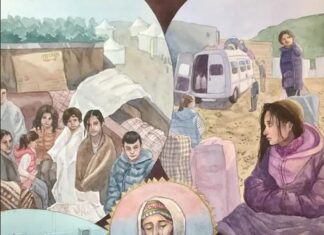By Aram Arkun
Mirror-Spectator Staff
LEXINGTON, Mass. — Project Save Armenian Photograph Archives celebrated its 40th anniversary with an evening program at the Scottish Rite Masonic Museum and Library on November 21. It was an enjoyable event, commencing with a cocktail reception at which guests, many of them distinguished leaders or activists in the Armenian community, socialized. The formal program was led by two masters of ceremonies, who are master photographers and on various boards of Project Save — Scout Tufankjian and Nubar Alexanian. Photojournalist Tom Vartabedian and Ararat-Eskijian Museum director Maggie Mangassarian-Goschin were given community commitment awards, while Project SAVE founder and director Ruth Thomasian addressed the audience.
Before the formal talks, a short documentary film depicting the work and history of Project SAVE prepared by Alexanian, who is a filmmaker as well as a photographer, was screened. The film gives a glimpse into Thomasian’s decades of selfless labor which led to the creation of an unparalleled collection of images and the stories which accompany the images. Some examples of photographs and the stories and information that they convey were presented. With much information about Armenian families and heritage destroyed or scattered around the globe thanks to the Armenian Genocide, her work of reassembling information is all the more important for both families and scholars who wish to study the past.
With quick and easy banter, the two masters of ceremonies first introduced one another and spoke about the value of Project Save. Tufankjian said, “The power of photography is not just that you can fold an image into your hand, the power of photography is that you can hold a family history in your hand.” Alexanian added that “in the collecting of these images, Project Save says no to the erasure [of our history caused by the Genocide] every day.”
Tufankjian showed some projections of her own photographs from her recent book documenting the global Armenian community, titled There Is Only the Earth: Images from the Armenian Diaspora Project, which took her to some 20 Armenian communities worldwide to commemorate the Armenian Genocide centennial. She revealed the commonalities between the various remote communities. She stressed that the Armenians are still one people, and still strong, with Project Save insuring the survival of their shared heritage in the US.









